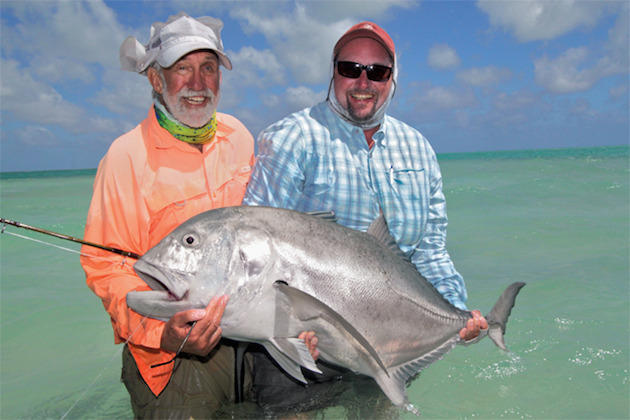For as long as I can remember, famous outdoor writers such as Joe Brooks, Zane Grey and Lefty Kreh fired my imagination with stories of lightning-fast apex predators that cruised the flats of the world’s tropical oceans. Bonefish, tarpon, and permit were all considered worthy opponents, but the GT was the one that held them all in awe.
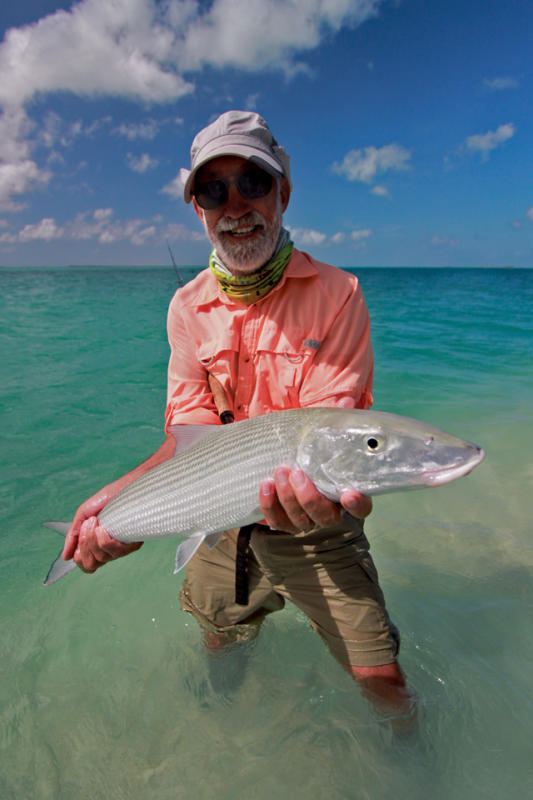
The author landed this 5-pound bonefish, which is much larger than the average bone around Christmas Island.
My quest for GTs had taken me to several tropical outposts, including Palau, Yap, and the far northwest corner of Australia. On each trip, I hooked and landed GTs, though none were truly giants. With more than 25,000 air miles under my belt in search of a trophy- class trevally, I had yet to see one worthy of the name. Then I began hearing stories about the huge fish that prowl the waters off Christmas Island in Kiribati, a group of islands in the South Pacific.
After countless conversations with adventuresome anglers and a great deal of Internet research, I knew Christmas Island was the place to hook, and if lucky, land a world-class GT.
Located at roughly the intersection of the International Date Line and the equator, Kiribati’s islands are scattered over some 1.5 million square miles of the Pacific. With less than 320 square miles of land, the island nation has 32 atolls. Christmas Island is the world’s largest coral atoll with a lagoon measuring more than 125 square miles.
My quest began when I contacted Jacob Teem, the owner of a small lodge called Ikari House. Even the name is fishy—ikari translates to “bonefish” in the local tongue. Teem assured me that his guides could show me numerous GTs, and that I would quite likely hook a few, though he made no promises that I would bring one to hand. I immediately booked my flight for Christmas Island.
When my friend Dave Kilhefner and I arrived the week before Christmas, I felt our timing might be propitious. With only one flight per week, the arrival of an airplane is an event at Christmas Island. A small crowd of locals, many dressed in traditional sarongs, came to greet us. Smiling faces were a welcome preview of the island people’s friendly nature.
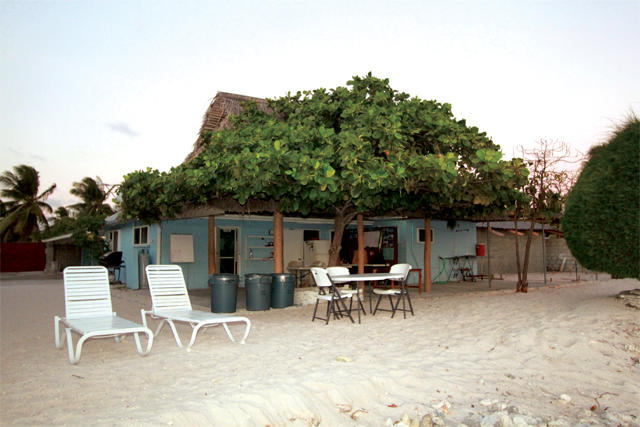
Christmas Islanders refer to these character-laden structures as ikari houses. Ikari means bonefish in the dialect of the locals.
Christmas Islanders refer to these character-laden structures as ikari houses. Ikari means bonefish in the dialect of the locals.
Immediately upon deplaning, I could see that Christmas Island was unique. Unlike many tropical islands, the trade winds that sweep across Christmas seldom bring significant rainfall, so the vegetation is sparse. Bare sand with a scattering of scrub brush is the norm and the land is as flat as a flounder. The highest spot is a mere 53 feet above sea level.
A 20-minute drive brought us to Ikari House, a cozy lodge that serves up to eight anglers. As it was close to the holiday season, we were the only guests at the lodge. Our guide, Simon Corri, met us as we unpacked and explained that the fishing had been good. We later learned that the fishing and the weather at Christmas Island are almost always fine. Simon told us we could expect to catch bonefish at will, particularly fish in the one- to two-pound class. He said we’d probably see between three and six giant trevallys per day, but hooking a big fish could be difficult and landing one nearly impossible. I told him we would be happy to spend some time targeting bonefish but a big GT was my ultimate goal.
Simon grinned and said, “That’s great. I love fishing for GTs.”
The next morning Dave and I boarded an open fiberglass skiff with Simon and his assistant, Tim. The scene before us was simply breathtaking all across the 12-mile-wide lagoon. The scattered flats ranged from one to four feet deep but varied widely in size, from only 100 yards to as much as a half-mile across. Each undulation in depth caused the water to vary in color, from a wide array of blues to a turquoise so brilliant it seemed other-worldly.
Tim and Dave stopped at a large bonefish flat armed with only a 7-weight fly rod, while Simon and I headed for an area that often held big GTs.
We motored to a large flat that rose from a depth of more than 40 feet where I began casting a big green-and-white minnow imitation tied on a size 4/0 hook. Simon told me to cast as far as possible into the deep water, let it sink for ten seconds, then strip line like a madman.
I tried to do as told but he advised: “No, you must strip faster. GTs are used to eating only things that are fleeing in terror.”
I finally found that the only way I could strip line fast enough to please Simon was to cast, then place the rod under my arm and strip with both hands. While this produced a satisfactory presentation of my fly, it soon proved to be exhausting. Casting a bushy fly on 12-weight line into a strong wind in 90-degree heat is akin to working out in a sauna.

The straightened hook on this baitfish imitation illustrates the awesome power of a giant trevally.
About the wind: Christmas Island lays smack dab in the path of those famous trade winds that blow almost constantly, enabling the early sailing ships to traverse the Pacific rapidly. But those same trade winds make fly fishing a challenge. Doing so with a 12-weight is doubly challenging. But I knew that anything smaller would be destroyed by a giant travelly.
After an hour or so of casting and stripping, Simon took pity on me and said, “Let’s go hunting.”

Dave Kilhefner’s happiness is evident in every aspect of his smile. The guide estimated the GT’s weight at 90 pounds.
We began wading across the flats, looking for the telltale splashes that telegraph the presence of feeding trevally. As we edged across the flats, we saw lots of bonefish, as well as large triggerfish, surgeonfish, milkfish, and the occasional puffer. But I was not interested in the small stuff.
When I marveled at all the life on the flats, Simon pointed out, “That’s not a good sign when you’re hunting for a GT. The smaller fish run and hide when they come.”
The day passed with no GT sightings, let alone hookups. As evening approached we picked up Dave who was ecstatic. He had hooked more than 40 bonefish, including several in the three-pound class. I was thrilled by his success and must admit for a minute I thought of trying to target bonefish the next day. But I had set a goal and was determined to achieve it.
The next two days were pretty much the same as our first. Dave caught bonefish almost at will, while I kept casting hummingbird-sized flies into the wind. Twice we saw trevallys terrorizing smaller fish up on the flats, but both times we spooked them before getting into casting range. Undaunted, I vowed to keep after them.
 On the fourth day Simon suggested we sit quietly and wait until we saw a pack of GTs cruising the edge of the flat. As my arm felt like putty from all the fruitless casting, I was happy go along with his suggestion. As we sat and chatted about our many angling adventures, Simon pointed out two small schools of bonefish and surgeon fish that had approached quite close to us.
On the fourth day Simon suggested we sit quietly and wait until we saw a pack of GTs cruising the edge of the flat. As my arm felt like putty from all the fruitless casting, I was happy go along with his suggestion. As we sat and chatted about our many angling adventures, Simon pointed out two small schools of bonefish and surgeon fish that had approached quite close to us.
While watching the bones feed, they suddenly spurted away, followed by the triggers and pufferfish.
“Get ready . . . GTs are nearby,” Simon whispered.
Simon saw them first, just as he always did, but eventually I was able to see the shadows of three huge trevallys cruising just beneath the surface.
 “Wait, don’t cast until they have gone past us,” Simon directed. “Once they have their backs to us, make your cast and wait till I tell you to begin stripping.” I did as told.
“Wait, don’t cast until they have gone past us,” Simon directed. “Once they have their backs to us, make your cast and wait till I tell you to begin stripping.” I did as told.
I’m sure I was holding my breath, and I know my hands were shaking.
Seconds later Simon said, “Here they come! Strip. Fast!”
I began stripping, then felt the slightest tug.
“Set the hook,” Simon shouted.
I strip-striked and reared back hard on the fly rod, knowing the 80-pound tippet and every knot had been tested, retested, and wouldn’t break, no matter how hard the fish pulled.
The huge GT raced away so fast I wondered if my drag was tight enough. I double-checked and found it as tight as it would go. Still, the GT sped away. In an instant the fly line was off the reel. In only a few more seconds I saw the knot where my first 200 yards of backing was attached to the next 600 yards.
Simon shouted for me to get up on the bow and hold the rod high overhead to keep the GT from dragging the line over the razor-sharp coral heads.
The fish finally stopped about 400 yards away, and I began working him back to the boat. After more than an hour I was able to get almost all of my fly line back and coaxed the big GT up onto the flat.
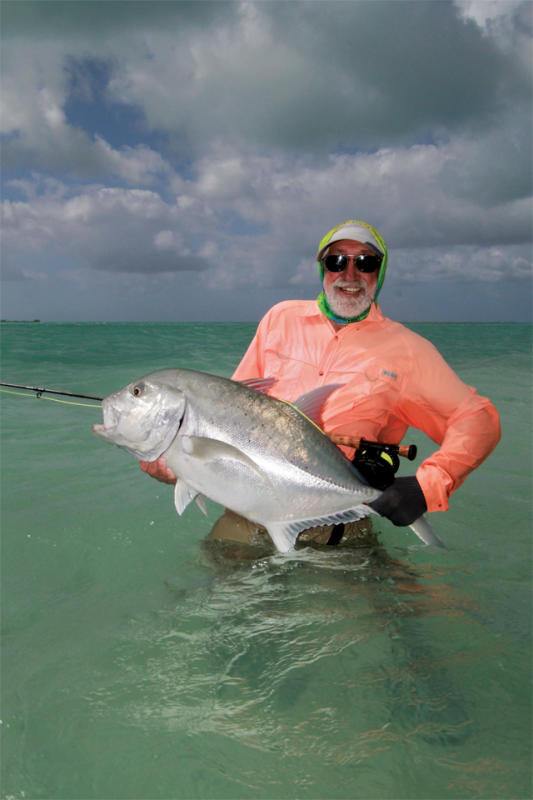
The author resorted to various tactics—running through the shallow surf, putting his back into the fight, and tag-teaming—to keep the giant trevally from reaching the horizon.
Tim waded out toward my prize and made a failed lunge for its tail. My heart leapt to my throat. I was certain we were going to lose him at this late juncture. But the next time Tim succeeded in grabbing the tail. The prize was mine!
I jumped into the water to hold my fish for a quick photo. That’s when I realized how huge it was. I was able to lift it but only because I had about a gallon of adrenaline coursing through my veins.
“That’s a huge GT,” Simon enthused. “I think it’s more than 90 pounds . . . the biggest one I’ve ever seen landed. It really is a giant.”
During our celebration back at the lodge, we decided to spend the remaining days exploring the island’s many other amenities. We knew blue-water fishing was an option and that several varieties of reef fish were available. Simon suggested we try for tuna and wahoo offshore, and we readily agreed.
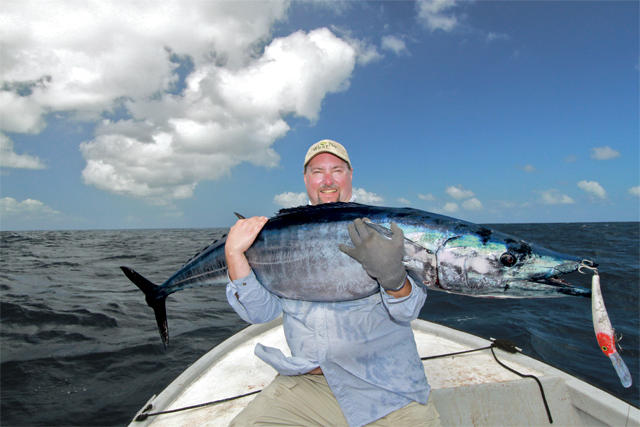
Five miles from the harbor, the fishermen watched helplessly as line peeled off the reel and thought they’d hooked a big tuna. It turned out to be a 100-pound wahoo that Dave Kilhefner battled for half an hour.
The next day we boarded another fiberglass panga and headed out to thousand-foot-deep blue water less than ten miles from the harbor. We began trolling with Rapalas designed to dive 18 feet, and within minutes the drag on Dave’s reel began singing that lovely fish-on song. Dave grabbed the rod and held on as line melted from his oversized spinning reel.
“I think it’s a big tuna,” Simon observed. It seemed likely, as two large tuna processing ships flying Ecuadorian flags were anchored not far from the harbor.
Dave battled the fish for more than 30 minutes before Simon said, “I don’t think it’s a tuna. It’s running near the surface and tuna seldom do that.”
Soon we made out a long, slender shape perhaps 40 feet below in the clear water. Simon, not a man to get excited easily, shouted, “My god, it’s a huge wahoo.”
Sure enough, moments later we gaffed the largest wahoo I’ve ever seen. That night we weighed the fish and found it to be almost exactly 100 pounds—truly an awesome catch. In two days Dave and I had each landed a world-class fish!

Along with an incredible variety of fish, Christmas Island lagoon is marked by a colorful palette of greens and blues, depending on the water depth.
We spent the next few days sampling everything else the island had to offer. Each morning Simon would ask, “What do you want to catch today?” And each time he put us on whatever species we asked to catch. One morning we motored out past the lagoon to catch reef fish, including several 40-pound GTs, on big poppers. On our return to port we came across a huge school of yellowfin tuna and hooked several 40-pounders on our surface poppers. Another day we targeted large bonefish and caught a number of six-pounders. We also hooked triggerfish, and cast to large schools of milkfish.
Every day was memorable. Dave and I agreed that this truly was a once in a lifetime Christmas present —a gift we intend to give ourselves again next year.
IF YOU WANT TO GO
Christmas Island fishing trips are one week in duration, as there is only one flight weekly to the island. You can depart from Honolulu or Tahiti; the Tahitian Airlines flight makes a circuit between the two areas.
Ikari House can accommodate only eight guests at this time, but the staff is planning to expand. A $50 fishing license is required, but everything except alcohol and gratuities is included. Rooms are clean, comfortable, and air-conditioned. Anglers sleep two to a room. Excellent hot breakfasts and dinners are provided at the lodge with a heavy emphasis on local delicacies such as lobster, wahoo, and tuna.
Anglers should pack a good selection of tackle because none is sold on the island. Fly fishers should take 7-, 9- and 12-weight rods, all with floating lines. Be sure to carry several spare lines as the coral can be tough on fly lines. If you plan to cast plugs to GTs and tuna, bring an 8- to 10- foot casting rod capable of throwing five-ounce plugs with a reel that can hold at least 500 yards of 80-pound braid. The Ikari House website provides a complete list of suggested tackle.
Call Ikari House at (480) 298-4405, email jacobteem@aol.com, or vist www.ikarihouse.com.
CHRISTMAS PAST
Christmas Island (also known as Kirimati) lies in the central Pacific and is not to be confused with the Australian territory that bears the same name but lies in the Indian Ocean. The former had long been a British holding but today comprises 70 percent of the land area of the Republic of Kiribati, an archipelagic nation of about 100,000 people.

Atomic blast and mushroom cloud over Christmas Island, 1962.
Atomic blast and mushroom cloud over Christmas Island, 1962.
During the 1950s and ’60s, Great Britain and the U.S. tested hydrogen and atom bombs in the vicinity of Christmas Island. The British detonated nine hydrogen bombs as part of Operation Grapple. Six of the explosions occurred in the atmosphere near present-day Kirimati.
In 1962 the U.S. launched Operation Dominic, a series of 36 atom-bomb detonations not far from Christmas Island. In the 1970s the British and American governments declared Kirimati clear of radioactivity. Regardless, fewer than 6,000 people live on the island and the fishing is outstanding. — Russ Lumpkin

